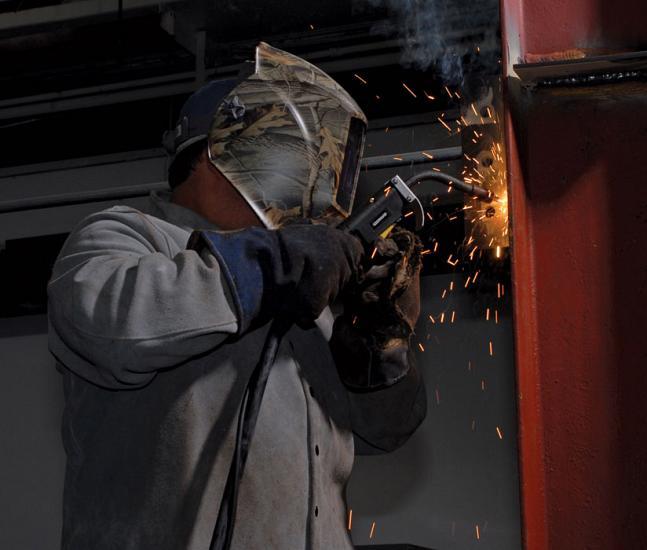- FMA
- The Fabricator
- FABTECH
- Canadian Metalworking
Categories
- Additive Manufacturing
- Aluminum Welding
- Arc Welding
- Assembly and Joining
- Automation and Robotics
- Bending and Forming
- Consumables
- Cutting and Weld Prep
- Electric Vehicles
- En Español
- Finishing
- Hydroforming
- Laser Cutting
- Laser Welding
- Machining
- Manufacturing Software
- Materials Handling
- Metals/Materials
- Oxyfuel Cutting
- Plasma Cutting
- Power Tools
- Punching and Other Holemaking
- Roll Forming
- Safety
- Sawing
- Shearing
- Shop Management
- Testing and Measuring
- Tube and Pipe Fabrication
- Tube and Pipe Production
- Waterjet Cutting
Industry Directory
Webcasts
Podcasts
FAB 40
Advertise
Subscribe
Account Login
Search
Top 5 in 365—Articles about consumables
- By Vicki Bell
- July 19, 2018

Vertical and overhead welding are inherently more difficult than flat/horizontal, in-position welding because you’re working against gravity. To weld successfully out of position, it is important to choose the right welding process and filler metals and use optimal parameters for the application.
Previous installments of Top 5 in 365 have focused on bending and folding, laser cutting, arc welding, assembly and joining, and automation and robotics. This post is about the consumables category on thefabricator.com, a technology area that has information on cutting tips, electrodes and wire, spatter prevention compounds, temporary purge dams, and welding torch components—the details that affect welding processes. Here are the top five most-read articles about consumables in the last year.
5. Comsumables Corner: Heat input and its effects on material properties
This article answers the questions: How does heat input from welding affect the mechanical performance of welded joints? Do preheat and interpass temperature have any effect on them as well?
4. 4 ways welding distributors can help weld shops
Take full advantage of the resources they offer
A local welding supply distributor is more than just a place to buy gas bottles, welding power sources, and consumables. From process analyses and safety audits to hands-on training and equipment demonstrations, many distributors can offer expertise and a foundation to grow your welding operation.
Spending some time in the shop or getting to know your rep better could greatly benefit your operations. Being upfront about your issues or desire for process improvements can go a long way as distributors have a lot of expertise and ways to help you do your job more efficiently.
3. Consumables Corner: Comparing filler metals for manual and robotic welding applications
This article answers the following questions: Our job shop manufactures various products; some parts we weld manually or robotically on a jig, others we custom-build and weld manually. We currently use gas metal arc welding (GMAW) to assemble all of our parts. Which is the best welding process or wire type for all variations of welding we do? How much of an effect does the wire or process have on overall speed and efficiency?
2. Consumables Corner: Tips for welding thin materials
This article addresses concerns about welding thin materials: We're an independent welding supply and distributor company. We frequently field an array of questions from our broad customer base. While we have straightforward answers for most questions, we seem to have difficulty finding common ground on the topic of welding thin materials. What are some best practices for welding thin materials that we can share with our customers?
1. Tips for out-of-position welding
Keys to success
Welding out of position is at times a necessity, and some processes and consumables are better suited to fit your needs than others. Read on to learn how to choose the right welding process and consumables and which common mistakes to avoid.
Next up? Cutting and weld prep.
subscribe now

The Welder, formerly known as Practical Welding Today, is a showcase of the real people who make the products we use and work with every day. This magazine has served the welding community in North America well for more than 20 years.
start your free subscriptionAbout the Author

Vicki Bell
2135 Point Blvd
Elgin, IL 60123
815-227-8209
About the Publication
- Stay connected from anywhere

Easily access valuable industry resources now with full access to the digital edition of The Fabricator.

Easily access valuable industry resources now with full access to the digital edition of The Welder.

Easily access valuable industry resources now with full access to the digital edition of The Tube and Pipe Journal.
- Podcasting
- Podcast:
- The Fabricator Podcast
- Published:
- 04/16/2024
- Running Time:
- 63:29
In this episode of The Fabricator Podcast, Caleb Chamberlain, co-founder and CEO of OSH Cut, discusses his company’s...
- Trending Articles
Sheffield Forgemasters makes global leap in welding technology

ESAB unveils Texas facility renovation

Engine-driven welding machines include integrated air compressors

How welders can stay safe during grinding

The impact of sine and square waves in aluminum AC welding, Part I

- Industry Events
16th Annual Safety Conference
- April 30 - May 1, 2024
- Elgin,
Pipe and Tube Conference
- May 21 - 22, 2024
- Omaha, NE
World-Class Roll Forming Workshop
- June 5 - 6, 2024
- Louisville, KY
Advanced Laser Application Workshop
- June 25 - 27, 2024
- Novi, MI


























